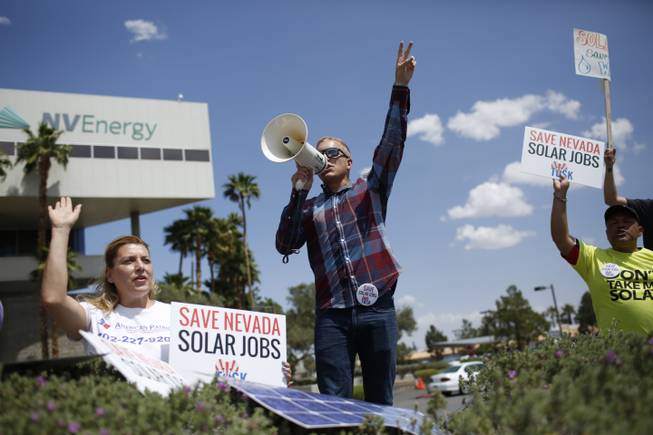
John Locher / AP
Michelle Balistreri and Chandler Gray attend a rally in front of NV Energy on Wednesday, April 22, 2015, in Las Vegas. Hundreds of activists gathered outside NV Energy headquarters in Las Vegas to protest a state cap affecting rooftop solar installations and urge the Legislature to lift it.
Wednesday, June 10, 2015 | 2 a.m.
The 2015 Nevada legislative session is over, but debates on solar and wind power, NV Energy and Western power production are as alive as ever.
Lawmakers have spent decades enacting policies to thrust Nevada into the epicenter of national conversations on consuming, creating and purchasing power with renewable sources and fewer fossil fuels. The state is decommissioning coal power plants and using more natural gas than ever. It’s No. 1 per capita in solar jobs and may one day be the emission-free engine that powers California.
Those legislative efforts have provided a steady stream of work for the Public Utilities Commission, which regulates power production and consumption. There’s little doubt regulators will be busy this summer as the solar industry, NV Energy and the state's largest electricity customers debate energy policy in the coming months.
The battle over rooftop solar power is moving from the Legislature to the commission after lawmakers approved a measure allowing the PUC to make key decisions on the issue. Tech company Switch and the state’s prominent casino companies will soon hear from the PUC if they can end current contracts with the power company. NV Energy, billionaire Warren Buffett’s power company that serves at least 2 million people, will join a power purchasing marketplace in October that connects utilities in California, Oregon, Washington, Utah, Wyoming, Oregon, Idaho and Arizona.
Here’s what to watch:
CAISO
In October, NV Energy will join what’s known as an energy imbalance market. The market is part of a network of interconnected transmission lines in the West run by the California Independent System Operators. The utility will plug into software that provides hourly rates per demand. So NV Energy will be able to go onto the CAISO spot market and buy power — when it is running short — at the lowest rate possible from utilities who participate in CAISO and operate across the west.
The idea is to increase power reliability in a world with increased dependence on renewables and greater consumer demand for electricity. The utility will pay a fee to join the market. But some advocates expect the utility to save at least $40 million over two decades by being part of CAISO. The reason: Currently, it's cost-prohibitive to try to store energy produced by solar arrays and wind turbines, so NV Energy needs a cheap source of power when the sun isn't shining and the wind's not blowing. Buying it through the system will be cheaper for NV Energy than producing it. Likewise, when it's sunny and windy here, NV Energy could provide a relatively cheap supply of electricity to other states in the system which might have less renewable power generation.
NV Energy will incur $11.2 million in one-time costs to join and spend $2.6 million annually, according to NV Energy.
Casinos and Switch
Some of NV Energy’s largest customers want to do business with someone else. It’s proving to be a difficult task. Today, the PUC will make a formal decision on whether Switch, the massive Las Vegas-based data center, can purchase and create energy without the utility. PUC chairwoman Alaina Burtenshaw on Monday issued a draft ruling that denied Switch from ending its current power purchase agreements with NV Energy. The draft signals that the three-member commission will agree with the chairwoman today. That flat-out denial will send a strong message to Las Vegas Sands, Wynn Resorts and MGM Resorts International — companies that applied in May with the PUC to exit the power company. To leave, companies will have to pay millions of dollars, prove their exit won’t affect the rates of other customers and receive PUC approval.
Net metering
The policy offers homeowners and businesses credits on their power bills for generating electricity to their homes, their buildings and to the grid with solar energy. It sparked more lobbying and closed-door battles than any other issue during the legislative session. The solar industry fought to lift a cap that had limited participation to 3 percent of its 7,500-megawatt peak capacity — a rate that solar advocates said would be hit this year. The utility said the credit was a subsidy and would be unfair to non-solar customers, who would bear the cost of maintaining infrastructure should more customers start using solar.
After months of inaction, lawmakers in the final days of the session devised a temporary solution by increasing a cap that limited participation. But they also mandated that the PUC devise a permanent solution by December that will likely include adding fees for solar customers. The solar industry and NV Energy have already begun working in the PUC on the matter.

Join the Discussion:
Check this out for a full explanation of our conversion to the LiveFyre commenting system and instructions on how to sign up for an account.
Full comments policy